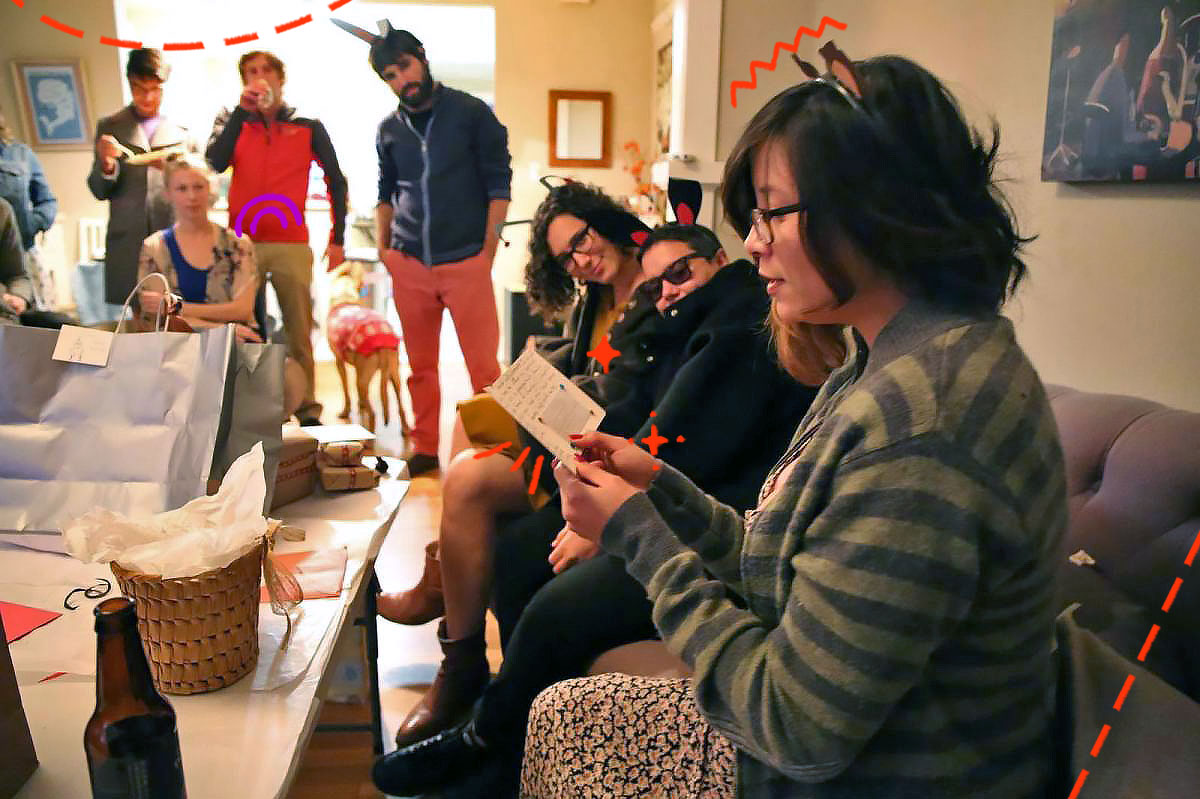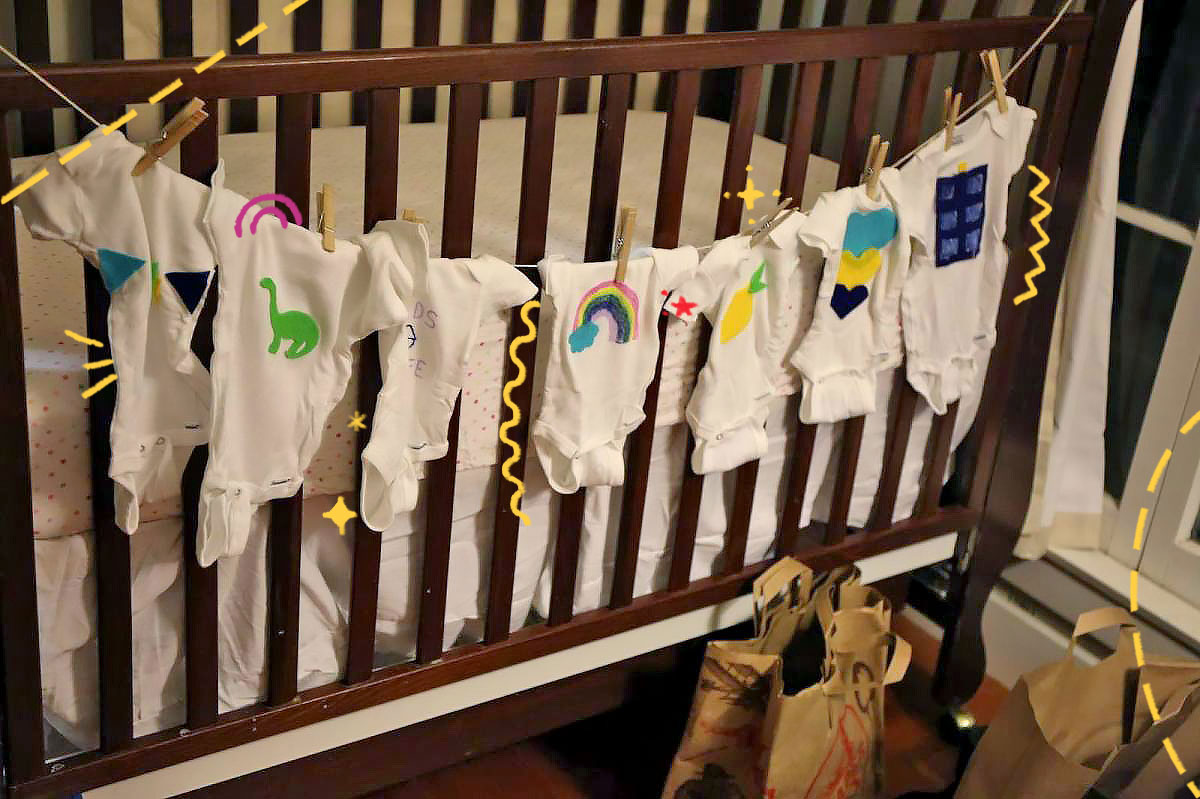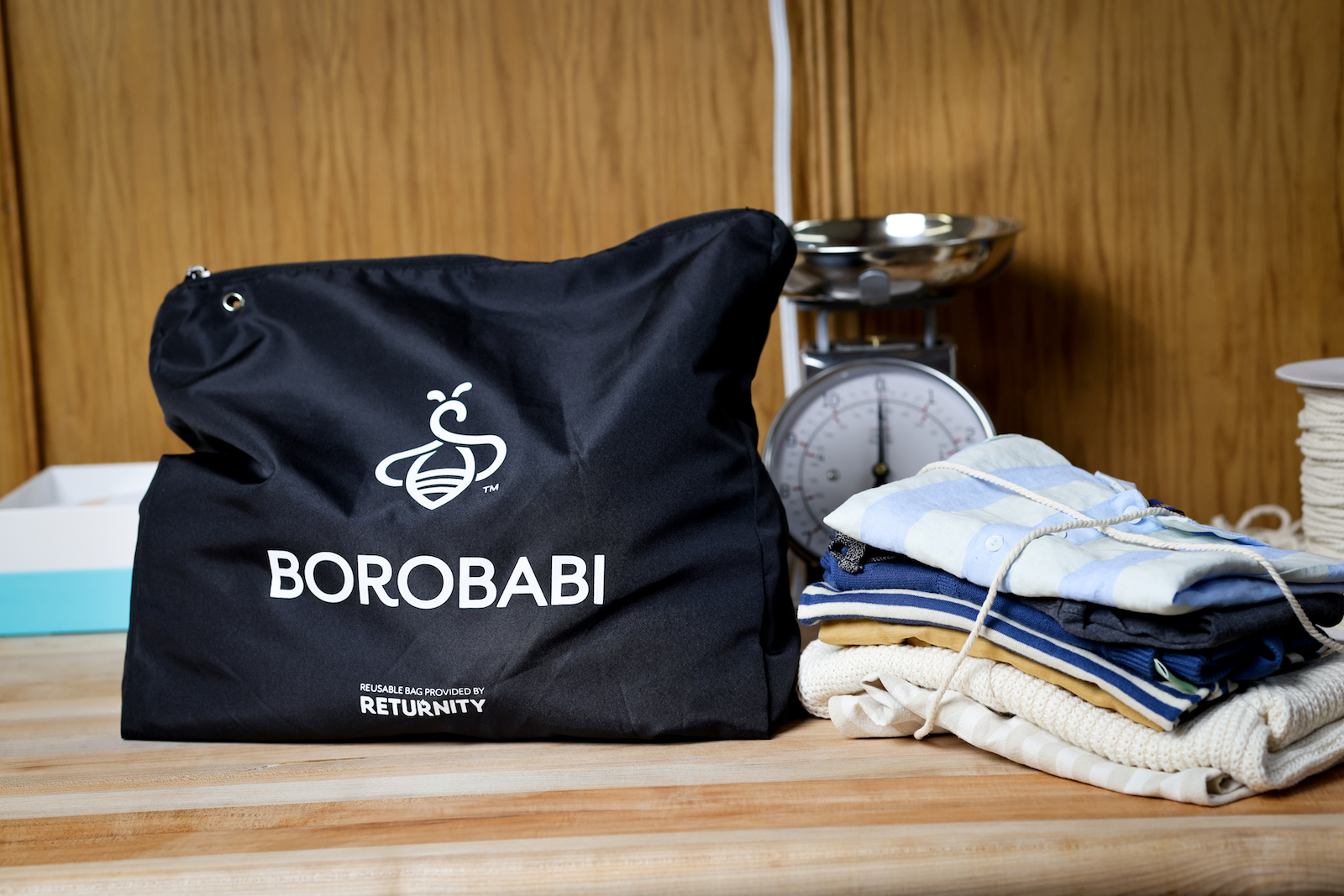This article is part of Ask Umbra’s guide on How to Dress for the Planet.
Nearly seven years ago, when I was pregnant with my first kid, a couple of my close friends from graduate school generously offered to throw my husband and I a baby shower. As tends to happen when you are the first person in your 30-something friend group to have kids, it was a highly entertaining combination of Instagram-worthy baby decor and day drinking.
On a warm Sunday in November, we crammed 40 adults, most bearing enormous pastel-wrapped boxes, into our 1044-square foot Bay Area bungalow, which had been decorated using a “wildland” nature theme. Bedecked in DIY construction paper animal ears, the group eventually gathered in hallowed baby shower tradition and made a giant circle. We all cooed as I tore into gift after gift to reveal dozens of brand new toys, blankets, books – and clothes, so many clothes. Dinosaur-print pajamas, fleecy winter zip-ups, itty-bitty baby bootlets with owl faces, swaddles, hats, sleep sacks, and a dozen white organic cotton onesies for guests to decorate.
As precious as those memories are, it’s hard to imagine enjoying a similar event today. It’s not just the fact that crowded, indoor social gatherings (especially involving pregnant people) have largely been on hiatus for the past two years. There’s a new sense of slight irresponsibility associated with the idea of showering someone with dozens of brand new items of clothing that will only last for a few months, tops.

Even within the already carbon-intensive fashion industry, children’s clothing is notoriously wasteful. Part of that is because little kids do so much growing. In the first two years of life, an average child uses over 200 pieces of clothing, each of which only fits for about two or three months. That may sound like a lot, but tiny kids aren’t exactly cut out for a minimalist capsule wardrobe. Once my daughter was born, I was shocked by the sheer number of outfits she could go through in a single day thanks to an explosion of one bodily fluid or another. After the first dozen blowouts, I learned to keep a full set of extra clothes in my purse, car, and stroller.
Having a few extra pieces of clothing around may seem innocuous, but all our unwanted apparel can really add up once it makes its way to the waste bin. In 2018, the U.S. produced nearly 13 million tons of clothing and footwear waste, 70 percent of which ended up in landfills. There isn’t clear data on how much kids contribute to the textile pile up: Their apparel makes up around 12 percent of the market share, but their waste contribution may be even higher than that, since they cycle through them so quickly and are more likely than adults to stain or rip their outfits.
For used outfits that remain in good condition, there is a thriving secondhand market for children’s clothing – sites like eBay and ThredUp, for example, are stalwart sources for buying and selling pre-loved kid gear. But for people like me who were contemplating having a second kid someday, the instinct is often to save resources and hold on to reusable baby items for a few years “just in case.”

In 2019, I got pregnant again, and one of the first things my husband and I did was assess our accumulated trove of used baby items. Even after countless trips to Goodwill over the years and having passed many pristine outfits to parents with younger kids, the stack of blue plastic tubs with labels like “3-6 months – jackets only” went from floor to ceiling. “Do you want us to throw you a baby shower or sprinkle for #2,” my sister emailed me a few months before my due date. “God no,” I told her. “I don’t want anything new. We have too much stuff already.”
I didn’t know it at the time, but my newfound anti-clutter kick was fairly on trend. According to Tom Szaky, CEO of the New Jersey-based recycling company TerraCycle, anti-waste sentiment really started taking off around the end of 2017 and hasn’t let up since. “When it comes to waste, people are at a much, much higher level of concern today than five years ago,” he said. “It is one of those things that you can’t unsee.”
The COVID-19 pandemic added to our single-use shame, as many grocery stores and cafes temporarily stopped letting customers use their own reusable cups and bags. And the combination of economic instability and environmental anxiety helped fuel the meteoric rise of the “Buy Nothing” economy. A large number of people turned to social media to exchange excess goods free of charge. As Fortune Magazine Senior Editor Beth Kowit wrote of a Los Angeles-based Buy Nothing group, “Members gave and received the likes of toys and kids’ clothes, the bread and butter of most Buy Nothing groups.”
Indeed, kid items are so ubiquitous on Buy Nothing Facebook groups that many neighborhoods have started family-specific subgroups. Posts on these forums often read like happier versions of the supposed Hemingway-penned six-word story: “Baby Shoes. Never Worn. Contactless Pickup.”
But even the most eco-minded adults may still want to make the occasional new fashion purchase for their littles – a choice that can feel intimidating given the current state of greenwashing. As Grist’s very own Umbra wrote way back in 2014:
“The term eco-friendly, when applied to clothes, gets a little tricky. Most modern textiles exact some form of environmental tax. Regular cotton is grown using tons of pesticides, but organic cotton must often be shipped to us from faraway lands and soaks up lots of water. Human-made materials like nylon and polyester come from petroleum. Toxins also get involved in the spinning, dyeing, and overall production of many fabrics. Really, it’s a pity kids can’t stick to their birthday suits forever.”
Consumers’ desire for sustainable clothing is trending up worldwide, and the baby clothing market is no exception. In March 2020, for example, Gerber Childrenswear LLC launched a new “elevated” line of baby basics called Gerber Modern Moments. All of the items are made with organic cotton in an apparent bid to increase their eco-friendly appeal. But it also takes green to go green: A pair of Gerber Modern Moments sage green and black rompers will set you back about $20 – almost twice the price of the non-organic equivalent.
But if you’re willing to be optimistic (in 2022 no less!), there are a slew of new companies with somewhat novel waste-reduction models for child apparel. Many of these ventures focus on resale, repair, and recycling options rather than your standard greenwashing campaigns.
In April of last year, for example, the popular kid clothing brand Carters partnered with TerraCycle to launch a free, national textile recycling program, called Kidcycle. People can sign up for an account, fill a box with any brand of kid or baby clothing that they can’t donate or give away, download a free shipping label, and drop the package off at any UPS location. The materials are then recycled, often ending up as insulation.

The New Jersey-based company Borobabi (pronounced “borrow baby”) claims to be America’s first circular retailer. Customers can rent or buy baby clothes made from natural materials, selecting from new or pre-owned items. For families who choose to buy an outfit, they can return it to the company when they’re done in exchange for store credit. The pre-owned items are either composted or cleaned and put back into circulation, depending on their condition. “On average, we can do four to five turns of the clothes,” said Emily Ryger, the company’s chief of communications. Borobabi was recently certified by the nonprofit B Lab as having met high standards of social and environmental performance, transparency, and accountability.
In the past two years, Ryger says the company has seen demand grow exponentially. “The market’s desire is for worthwhile options in the face of climate change,” she said.
Szaky, himself a father of three kids, also sees a lot of promise in looped models for baby clothing — ones that allow an item to be returned in good condition and used again. One key reason is that clothes for very young children have the fastest consumption cycle. That quick turnover is attractive to companies that are willing to clean and resell pre-owned items instead of making new ones.
“Reuse can be a win-win for companies and consumers,” Szaky said. “Of course the very best thing is to buy less, but you also have to consider the sentimental factor, especially around baby clothes. Some people like to buy them and others find it difficult to let them go. I think the biggest miss we have in the sustainability space is hoping for a behavior change or talking about behavior change when really people don’t want to.”
Here’s the thing about parents of young children: We want a better future for our kids, we really do. And many of us are very, very aware of the horrors that await future generations if we don’t curb our emissions and consumption habits ASAP. But the truth is, we are also so effing tired. Like physically, mentally, and spiritually tired. That can make the siren song of consumerism hard to resist, even when it comes to something as innocuous as curbing the wastefulness associated with what our kids wear.
Hopefully parents in the near future won’t have to agonize as much between climate and convenience. But the good news is, I don’t think it’s necessary to hold ourselves to some unrealistic purity test in order to do better. And every time I successfully make a bag of my kids’ old stuff disappear into the arms of a grateful new family, or stuff my son into my daughter’s old hand-me-down leggings, I fully plan to celebrate the victory.
This story was originally published by Grist with the headline How to dress your growing kid, less wastefully on Mar 2, 2022.
This content originally appeared on Grist and was authored by Teresa Chin.
Teresa Chin | Radio Free (2022-03-02T11:40:00+00:00) How to dress your growing kid, less wastefully. Retrieved from https://www.radiofree.org/2022/03/02/how-to-dress-your-growing-kid-less-wastefully/
Please log in to upload a file.
There are no updates yet.
Click the Upload button above to add an update.